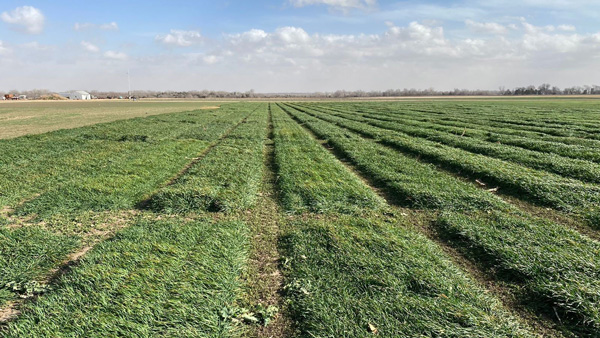Fall forage yield is an important aspect of dual-purpose wheat production. In this system, wheat is typically sown earlier than for grain-only production, at higher seeding rates and with additional nitrogen fertilizer to maximize forage production.
The weather experienced during the fall is crucial to determine an average level of forage yield, with warm and moist weather typically resulting in greater yield than cool and dry weather conditions. Management practices that also maximize forage yield are early sowing, higher seeding rates, placement of in-furrow phosphorus fertilizer with the seed, and fall nitrogen fertilization.
While the weather is typically the most significant player in determining fall forage production, followed by management, there are differences among wheat varieties in forage production potential. Thus, the K-State Wheat Production Group compares the forage yield of several commonly grown wheat varieties and upcoming lines every year. This test is usually performed in the South Central Experimental Field near Hutchinson, Kansas (Figure 1), and the forage sampling occurs sometime during December (Table 1)
The sampling was conducted on December 12, 2024, and showed significant differences among varieties regarding forage accumulation. The average forage yield was 1,556 lbs of dry matter (DM) per acre, with a range from 826 to 1,970 lbs DM/a. The varieties that exhibited the highest forage yield were AP Sunbird, KS Ahearn, KS Providence, and KS Territory, which were statistically greater than KS Mako. The other varieties were not statistically different than the highest or lowest forage group.

Figure 1. Dual-purpose wheat trial near Hutchinson, KS. Photo provided by Romulo Lollato, K-State Research and Extension.
Table 1. Fall forage yield of wheat varieties sown under dual-purpose system near Hutchinson, KS. Forage was collected on December 12, 2024. Data is shown for the average of four replicates and the standard error of the mean (SEM), both in pounds of dry matter per acre (lbs DM/ac). Grouping is shown based on Holm-Sidak test. There were significant statistical differences among varieties at the 5% probability level. Varieties are listed in alphabetical order, and the bold highlight indicates the highest forage-yielding group.
|
Variety |
Fall forage (lb DM/a) |
SEM (lb DM/a) |
Group |
|
AP24 AX |
1632 |
75 |
ab |
|
AP Sunbird |
1803 |
166 |
a |
|
CLH10-153.022 |
1835 |
252 |
ab |
|
CLH10-1853.014 |
1426 |
110 |
ab |
|
KS Ahearn |
1881 |
254 |
a |
|
KS Bill Snyder |
1481 |
95 |
ab |
|
KS Mako |
826 |
48 |
b |
|
KS Providence |
1970 |
179 |
a |
|
KS Territory |
1856 |
135 |
a |
|
KS21H36*0 |
1682 |
114 |
ab |
|
Kivari AX |
1310 |
29 |
ab |
|
Sheridan |
1511 |
174 |
ab |
|
AR Iron Eagle AX |
1161 |
89 |
ab |
|
AR Turret 25 |
1658 |
370 |
ab |
|
CP7017AX |
1154 |
196 |
ab |
|
CP7869 |
1710 |
192 |
ab |
|
Minimum |
826 |
|
|
|
Maximum |
1970 |
||
|
Average |
1556 |
|
|
Another important aspect of dual-purpose wheat production is how long each variety can be grazed in the spring. This is measured as the date of first hollow stem, and varieties can differ in as much as 20-30 days in achieving first hollow stem in the spring. The Wheat Production Group at K-State uses this very same trial to measure for first hollow stem during late February and early March, so keep tuned in for more information to come.
Romulo Lollato, Extension Wheat and Forages Specialist
lollato@ksu.edu
Wheat Production Group: Luiz O. Pradella, Jazmin Gastaldi, Gabriel Corte, Aron Gama, Gabriely Fattori, Sarah Ferreira, Agustin Cauda, Guido Ciarrocchi, Gregori Lopes, Lais Muller, Lauro Faccin, Jorge Cuellar
Tags: wheat fall forage dual purpose